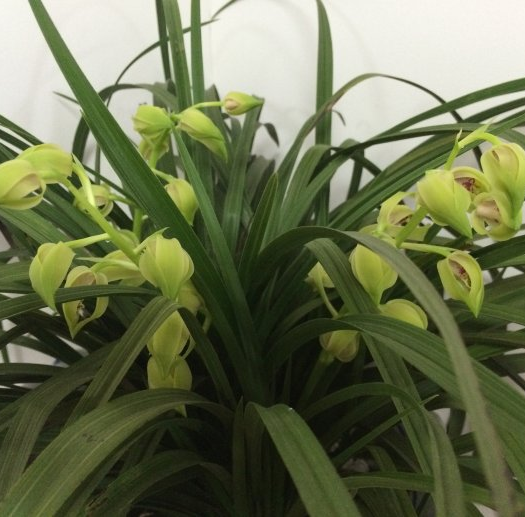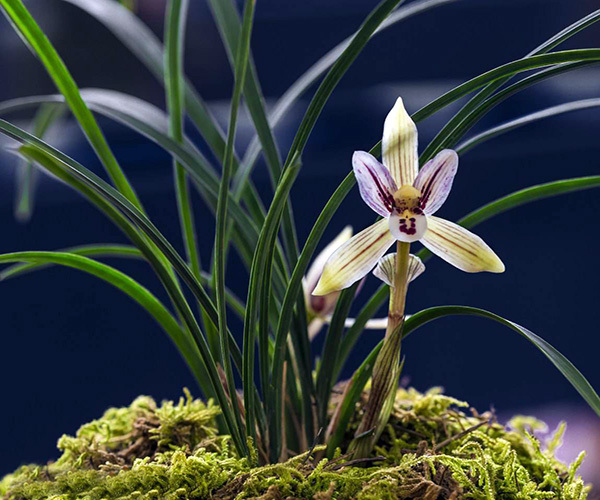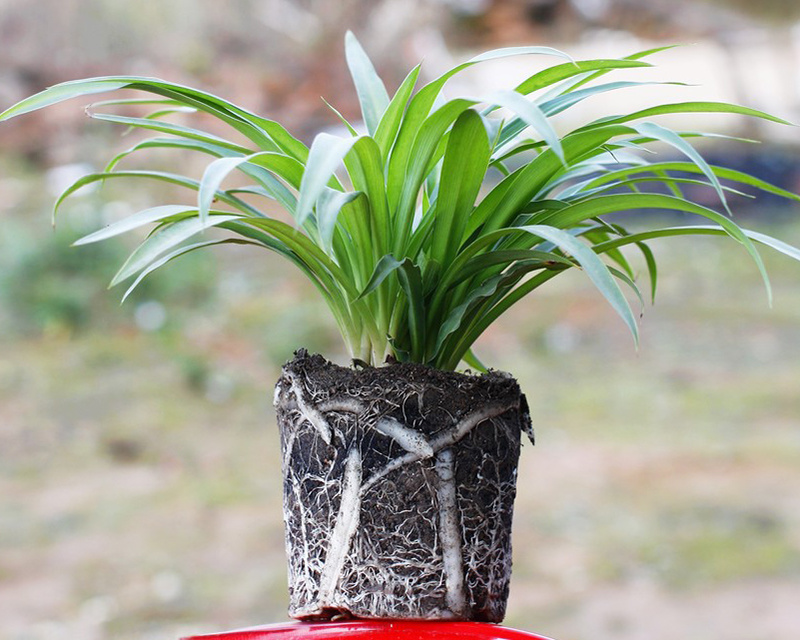Methods and matters needing attention in Orchid Culture

Soil selection
The soil for orchid should be mainly humus, mainly humus soil or mountain humus soil. In the south, humus soil of origin, commonly known as orchid mud, can also be used to prepare loose, aerated and permeable culture soil with saprophyllite, vermiculite, perlite and so on. Generally, 8 parts of rotten leaf soil and 2 parts of river sand were mixed into culture soil, or 7 parts of rotten leaf soil, 2 parts of perlite, 1 part of river sand mixed culture soil, or 6 parts of rotten leaf soil, 3 parts of compost soil and 1 part of river sand mixed culture soil. All the above culture soils are slightly acidic.
Fertilization method
Orchid fertilization, one is to apply base fertilizer in the culture soil, and the other is to topdressing during the growing period. Topdressing often uses liquid fertilizer or foliar fertilizer, and its concentration should be lighter than that of other flowers. Orchids change the culture soil once a year, apply less topdressing during the growth period, and pay attention to timely. Generally, in the growing season, about 15% of fully mature thin cake fertilizer water can be applied, or 0.1% urea fertilizer water plus 0.2% potassium dihydrogen phosphate fertilizer water, once every 15 days; before flowering to the flowering stage, 0.2% potassium dihydrogen phosphate or plant ash water can be sprayed on the leaf surface for 2 times to promote the development of roots, stems and flowers. Orchids are fleshy roots, do not apply unripe fertilizer, so as not to rot the roots.
Watering method
Watering orchids should be determined according to species, growth conditions and local climate, should be moist but not wet, dry but not dry; watering should not be too much or too little, and grasp the principle of not drying in autumn and not wet in winter. If the winter temperature is low, the plant is in a dormant state, and watering should be controlled. Generally, it can be watered every 5-7 days, but the flowering cymbidium in winter needs more water; in spring and autumn, it is watered every 2-3 days; in summer, the temperature is high, and the orchid is flourishing, watering once or twice a day on average. When watering, we should pay attention to prevent water spots from splashing on the leaves, so as not to appear black spots and affect the ornamental effect. During the growth period of orchids, water should be often sprayed on the leaves and sprinkled on the ground around flowerpots in summer to increase air humidity and promote the growth and development of orchids. Rain Water and Xueshui are the best water for watering orchids. If tap water is used, it should be stored for 2-3 days.
Temperature requirement
Northern potted orchids should be moved indoors when the temperature drops to 5 ℃ before and after the Frost Festival, and windows should be often opened at the initial stage to maintain ventilation. It is suitable to keep the room temperature about 10 ℃ in winter. Grain Rain later moved to the outside for maintenance. The suitable temperature for orchid growth is 16: 24 ℃. In winter, the indoor temperature is generally low, 10: 12 ℃ in the daytime and 5: 10 ℃ at night, the temperature and humidity should not be too high, and the summer temperature should not exceed 30 ℃.
Culture methods and matters needing attention of Orchid
Lighting requirement
Orchids like shade and are afraid of bright light, so they should be shaded in spring, summer and autumn. For family orchids, in order to control the amount of light, it is best to put them on the balcony windowsill or under the eaves with bamboo shade, generally shading from 9 am to 6 pm, and opening the curtain after 6 pm in the morning and after 6 pm to make it accept scattered sunlight. In winter, it should be moved to the place where the scattered light is visible indoors, but direct sunlight should also be avoided. The shade tolerance of orchids was the strongest, followed by Jian Lan, while Chunlan and Cymbidium were weaker.
What are the methods and matters needing attention in orchid culture?
Orchid is a symbol of loyalty. Orchids in traditional Chinese flowers only refer to several species of terrestrial orchids distributed in Chinese orchids. This kind of orchid is very different from the tropical orchid with large and colorful flowers. It has no eye-catching gaudy state and no large flowers and leaves, but it has a simple, quiet, elegant and elegant temperament, which is very complex with the aesthetic standards of Orientals. it has been cultivated for more than a thousand years in our country. Today, what the editor is going to introduce to you is about the cultivation of orchids.
[growth habits] Orchid it likes the cold environment, afraid of direct sunlight on it, but also likes the wet environment, the most taboo is the dry climate, and it also likes fertile soil rich in humus, the most suitable for growing in a well-ventilated environment.
[culture method] fertilization: for orchids, it is impossible not to apply fertilizer, but not to apply more fertilizer and re-apply it. If the new orchid goes to the pot, the pot soil is too fat to survive, and even if it can survive, it rarely blossoms. If the summer fertilizer is too much, the autumn leaves are flourishing, which often leads to poor flowering of the leaves in the next spring. If there is too little autumn fertilizer, it will affect the formation of underground flower buds at the turn of autumn and winter. If the usual nitrogen fertilizer is too much, the leaves are too fat, so that the growth of leaves and flowers are malnourished, there will be no flowering or less flowering phenomenon. Generally speaking, new leaf buds can be applied several times with a small amount of light fertilizer. The Spring Equinox, the Autumn Equinox and about 20 days after the flower fade are both more appropriate seasons. The best fertilization time is in the evening, and water is watered again in the next morning. Apply once every 2-3 weeks. Watering: dichotomous humidity is the best, watering relatively less during its flowering period and its budding, and moving back indoors during the rainy season, or building shelter for it. It can be watered in the early morning or evening in summer, of course, not too much, the amount of water can be increased appropriately in autumn, and it can be sprayed every evening in the dry season. Sometimes it is best to spray several times a day, watering should be watered from the edge of the basin, not on the head, not at noon. Although watering in winter can be greatly reduced, but it is not irrigated, be careful not to let the basin soil dry thoroughly, the early winter and spring and watering make the leaf sheath along the wet, to be moved into the room after drying, so as to avoid decay.
So we should pay attention to the problem of light when we cultivate it. In spring and summer, orchids are best shaded by Reed curtains, or placed in indoor windows that face east and south. Orchids under the curtain should be turned into pots once every semimonthly, so that orchids are exposed to light on all sides, which is beneficial to the balanced growth of plants. When it is cool in autumn, the pot orchid should be removed from the shade and let it bask in the sun for half a day in the morning, but pay attention to the autumn. Spend the winter under the indoor south window in cold weather, but it is not necessary to be too warm, it is best to cover with a plastic film cover to maintain proper humidity on the leaf surface. Place: the place where orchids are placed is very important, it can directly affect the growth and development of orchids.
The efficacy and function of Orchid methods and points for attention in Orchid Culture
Orchid has a pleasant aroma, orchid is one of the top ten famous flowers in China, loved by everyone, this kind of orchid has always been favored by people. So do you know the efficacy and function of orchids? Do you know the methods and precautions of orchid culture? I don't know. It doesn't matter. Let's follow and have a look.
I. the efficacy and function of orchids
1. The parts where orchids can be used are roots, leaves, flowers, fruits and seeds. It can be said that orchids are treasures all over the body. The medicinal value of orchids is very high. The roots of orchids can treat tuberculosis and lung abscess and sprain. The roots of orchids can also be taken with bone grafting and Jianlan root decoction, which is a good medicine for birth.
2. The leaves of orchids can cure infantile pertussis, the fruits of orchids can stop vomiting, and the seeds of orchids can cure nebula. The whole grass of Cymbidium among orchids can be used to treat women's diseases.
3. The whole grass of Chunlan among orchids can treat neurasthenia and play a good role in Ascaris lumbricoides and hemorrhoids. The leaves of Jianlan can also treat deficiency of lung qi, while the pedicels of orchids can also treat ringworm. And Suxinlan and Huilan petals also have the role of promoting the birth.
4. Orchids can also nourish Yin fluid, which is good for nourishing body fluid and moistening dryness, as well as for the treatment of malignant tumors. Orchids are a kind of pungent, smooth, sweet and non-toxic Chinese herbal medicine. It is recorded in the Compendium of Materia Medica. In modern Chinese medicine, orchids are mainly used to cool blood and moisten the lungs, as well as to treat dry cough, tuberculosis and leucorrhea.
2. Methods of orchid culture
1. Cushion basin
The bottom of the basin is covered with a tile, and then gradually filled with bricks, tiles or shells, in which the large gap is filled with mud or pea stone, which is generally about the height of the basin. The net height of the rest is about 10-15 cm, which is reserved for culture soil. Its specific height should be determined according to the type of orchid, the length of the orchid root and the height of the basin. The bedding should not be filled too close and too solid, and a little hole should be retained.
2. Planting
On the cushion layer, fill in 2cm or 3cm of culture soil first and compact it slightly with your hand. According to the size of the plant and flowerpot, you can plant several individual plants, 2 clumps, 3 clumps or more clumps in one pot. 3 clusters should be planted into a tripod. Four clumps can be planted in a square, and five clumps should be arranged in the shape of plum blossoms. Langen should stretch naturally, and the leaves should be covered in all directions.
To slowly put the Langen into the basin, so that the Langen naturally stretch, try not to rub with the inner wall of the basin. After the orchid plant is put into the basin, the posture of the orchid plant is gradually fixed. When potted in a clump, the old false bulbs should be deviated to one side, so that the new buds have room for development. If several clusters are planted in a pot, the old false bulbs of each cluster should be relatively gathered in the middle of the pot, so that there is enough room for new roots and buds to develop outward.
3. Fill
When planting, hold the leaves in one hand and add nutritious soil in the other to hold the base of the orchid plant up slightly to stretch the root system and shake the orchid basin at the same time. Let the culture soil go deep into the rhizosphere; continue to add soil, shake the orchid pot, and adjust the position and height of the orchid plant. Press along the edge of the basin by hand, but do not overweight and hurt the root, continue to add soil and squeeze until the basin soil is 2cm higher than the mouth of the basin, slightly in the shape of steamed bread. 4. Watering
After the planting is completed, water must be watered for the first time, so that the basin soil must be soaked, the water droplets should be small, and the impulse should be avoided. If immersed in a basin, do not soak for too long. As soon as the basin soil is soaked, move the orchid basin out immediately, and then move it to a shady place for maintenance.
5. Fertilizer
Orchids like light, fertilization is better light than thick. Like other plants, nitrogen can promote the growth of stems and leaves. Phosphorus can promote the development of orchid root, promote the development of reproductive organs, and stretch the stems and leaves. Magnesium, sulfur, iron and other trace elements can make leaves green and flowers strong.
More fertilizer should be applied during the peak growth period of orchids, but not during dormant or weak growth periods. If excessive fertilization, the roots and leaves will be burned, resulting in irreparable losses.
Matters needing attention in orchid culture
1, the pot is not too large-small plants grow in large pots, the amount of plant material is large, it is easy to lead to poor ventilation, watering is not easy to control. If watering absorbs too much water, the plant material is not easy to dry, and bacteria invade and cause rotten roots.
2. Orchids should be planted shallowly-do not plant orchids too deep, otherwise long-term moisture will rot. When planting, filling the root, base, or pseudobulb must be exposed.
3. The roots should be unfolded-when planting orchids, the roots should be evenly expanded and should not be squeezed together, so that each root can touch the plant material and ventilation is good.
4. No watering for several days-the roots of newly planted orchids may be injured, and the wound is coated with fungicides, which can not be watered for 3-5 days to achieve efficacy and promote the growth of new buds and roots.
5. Avoid strong light-newly planted orchids must avoid direct sunlight to prevent dehydration. They should be placed in a warm and shady place, and spray can be used to increase the humidity in the air until the orchids return to normal growth.
The above is what I want to tell you. I hope you can have a better understanding of orchids after watching it.
- Prev

How do orchids multiply in large numbers
For mass propagation of orchids, we should pay attention to the location, growth conditions, and growth environment, and pay special attention to the following three points: 1. Location: the place where orchids are propagated in large quantities is very important, which directly affects the growth and development of orchids.
- Next

Rooting methods and matters needing attention in Propagation of Cymbidium
The method of stolon reproduction is to cut off the stolon from the mother plant, it is best to cut off the stolon with many air roots, which is beneficial to the future growth. After flowering, the stolon begins to grow new leaves, followed by air roots. Cultured in water in a relatively small open container, the amount of water is just higher than that of the air root, so that
Related
- Fuxing push coffee new agricultural production and marketing class: lack of small-scale processing plants
- Jujube rice field leisure farm deep ploughing Yilan for five years to create a space for organic food and play
- Nongyu Farm-A trial of organic papaya for brave women with advanced technology
- Four points for attention in the prevention and control of diseases and insect pests of edible fungi
- How to add nutrient solution to Edible Fungi
- Is there any good way to control edible fungus mites?
- Open Inoculation Technology of Edible Fungi
- Is there any clever way to use fertilizer for edible fungus in winter?
- What agents are used to kill the pathogens of edible fungi in the mushroom shed?
- Rapid drying of Edible Fungi

